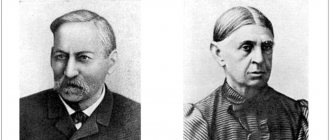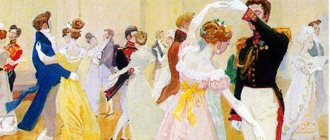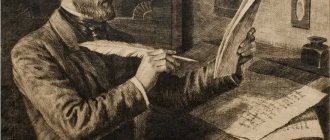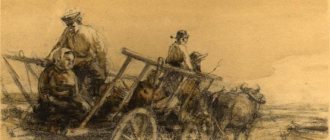Ivan Bunin, who won the Nobel Prize in Literature in 1933, wrote many works that were praised by his colleagues. One of the most discussed stories by critics was “The Mister from San Francisco,” the history of whose creation deserves special attention. The protagonist's journey across the ocean on the huge cruise ship Atlantis became a metaphor for the fragility of human existence and a warning to those who value ostentatious luxury and social status above caring for the world and its wonders.
History of writing the work
This parable story was published in 1915 in the collection “The Word” and reflected the alarming spirit of the end of an entire era. The history of its creation was influenced by Bunin’s apocalyptic mood, who never stopped thinking about the “Revelation of John the Theologian” and even took from it the epigraph “Woe to you, Babylon, strong city!” Later he crossed it out, not wanting to make the main idea too obvious.
Researchers note that Bunin was prompted to write the story by three events:
- Translation into Russian of Konrad Gunter’s work “Ceylon. Introduction to the world of the tropics." Bunin liked the lyrical digressions, descriptions of nature and memories of Gunther’s youth so much that he used them as the basis for several scenes describing Gunther’s journey aboard the Prince Ludwig and the places he happened to visit during his travels.
- Gorky's letter to Bunin, written in 1912, where the writer told him about a woman who, with great difficulty, achieved a successful position in society, but died of a heart attack at a ball. “Here is the 20th century for you,” Gorky wrote gloomily to a friend.
- In the summer of 1915, Bunin noticed a translated edition of “Death in Venice” by Thomas Mann in the window of the Gautier bookstore not far from Kuznetsky Most. The cover of the publication struck him so much that the future author of “The Gentleman from San Francisco” remembered it a few months later, when he was visiting his cousin in the village of Vasilyevskoye, Yeletsk district, Oryol province.
Although the writer never bought the book in the summer, he later said that the appearance of the cover evoked associations in him with an event that happened in Capri the previous winter, a year before writing the novella at the estate. On the island, the writer lived at the Kwisiana Hotel. One day he heard about the death of one of the guests, who turned out to be an American who came there on vacation.
The incident formed the basis of a story entitled “Death on Capri.” Bunin crossed out the original title as soon as the first line appeared on paper. This is how the story got its name, a phrase from which is repeated as a refrain throughout the entire work.
The history was written from August 14 to 19, 1915. Bunin wrote leisurely, enjoying the tranquility of the quiet autumn days in the estate. The city of San Francisco, from which the main character of the story arrived in Capri, was chosen arbitrarily by the author, since he did not know any details about the life of the American. Bunin read the famous , noting that the book seemed “unpleasant” to him.
History of creation
An important quality for a writer is observation, because from the most fleeting episodes and impressions you can create a whole work. Bunin accidentally saw the cover of Thomas Mann’s book “Death in Venice” in a store, and a few months later, when he came to visit his cousin, he remembered this title and connected it with an even older memory: the death of an American on the island of Capri, where the author himself was vacationing. This is how one of Bunin’s best stories turned out, and not just a story, but a whole philosophical parable.
This literary work was enthusiastically received by critics, and the writer’s extraordinary talent was compared with the gift of L.N. Tolstoy and A.P. Chekhov. After this, Bunin stood with the venerable experts on words and the human soul on the same level. His work is so symbolic and eternal that it will never lose its philosophical focus and relevance. And in the age of the power of money and market relations, it is doubly useful to remember what a life inspired only by accumulation leads to.
Text stylistics
Although Bunin wrote the story very quickly and briefly, the plot was based on his observations made during several travels. The image of Atlantis and the ship named after it, wandering over the abyss, already appeared in the poem “The Call,” written in 1911. While working, the author created several draft versions, ruthlessly editing the text to reduce the number of comparisons to a minimum. As a result, the style of the story has become extremely laconic, and the author’s speech seems rather dry.
Understanding who wrote “The Gentleman from San Francisco,” the reader will not be surprised by the lack of edifying rhetoric. The author decided to abandon the clearly stated moral of the story, leaving readers to draw their own conclusions. The writer was so excited by the topic of equality of people in the face of death and deeply rooted social inequality during life that he was often distracted from work.
Main character
The characterization of a rich American is the main part of the analysis of Bunin’s “The Gentleman from San Francisco.” What did the author tell about his hero? First of all, it is worth saying that Bunin did not name him. Even in a brief analysis of "Mr. from San Francisco" this should be mentioned. The American billionaire is a faceless character who has neither a name nor characteristic external features. As has already been said, he belongs to a society in which individuality is excluded.
The image of a rich and self-confident American created by Bunin is unattractive. From the first lines, the reader understands that this is a rather limited person, convinced of his power. He worked tirelessly for many years. Once upon a time, in his youth, he took one of the rich men as a model and, it seems, achieved his “greatness.” Now, at the age of 58, I have finally decided to take a break. She goes to Europe not because she has long dreamed of visiting famous sights. This is what all the people around him do.
Bunin did not mention the names of the wife and daughter of the gentleman from San Francisco. Analysis of the work includes characteristics of minor characters. That’s why it’s worth saying a little about the main character’s family. The wife is a contentedly indifferent lady, but, like all American women, she is a passionate traveler. The daughter dreams of love. The girl is very interested in the mysterious character of “Atlantis” - the crown prince of a certain Asian state. It is worth paying attention to this point. The young American woman is a typical daughter of her father. She is incapable of real feelings. An unattractive and unpleasant man with a black mustache arouses her interest only because he is rich.
Features of the composition
Even without knowing the author’s other works, but being familiar with the features of Bunin’s style, the reader will notice the unusual structure of the narrative, built on oppositions.
The author persistently focuses on the dualities of the imaginary and the real, the danger of the sea elements and the seeming serenity of the world of a cruise ship. He also created two images of the island of Capri: dark and joyless, as it seems to the main character upon arrival, and illuminated by the morning sun, as the wanderers see it.
The story is usually divided into two main parts:
- In the first, the reader sees the life of the ship, people, city and island through the eyes of the protagonist, only occasionally, thanks to the author’s skillful touches, noticing the outlines of the real world, which become more and more distinct with each page. Servants, hotel staff and merchants fawn over the rich American, obligingly fulfilling all his wishes, but after a sudden attack in the reading room, only his wife and daughter remain with him, who, having recovered from the shock, quickly begin to solve practical issues.
- The second part of the journey begins with the death of the hero, when the coffin with his body, securely hidden from prying eyes in the hold of the ship Atlantis, sets off on its return voyage across the Atlantic.
The main character is used to treating people with contempt. The workers interest him only as a potential source of profit; he openly examines the beauty on the ship, not paying attention to his daughter’s embarrassment, and after arriving at the hotel, he contemptuously fences himself off from the other guests with an unfolded newspaper. He is one of those who take insincerity at face value, not noticing that the loving couple on the ship, whom the passengers are watching with interest, was specially hired by Captain Lloyd and is mechanically putting on a performance for everyone.
Like the death of the mythical Atlantis, the death of a hero in a small town comes as a surprise , and his life, wealth, status, aspirations instantly depreciate, as if disappearing into the depths of the sea. Against this background, the lives of ordinary Italians who know how to see the real beauty of the world seem more real.
"Atlantis"
The ship on which the main character is sailing is easily recognizable as the Titanic. “Atlantis” is a separate world, living according to its own laws. In Bunin's work, this steamer is a symbol of civilization, wealth, power - everything that can be destroyed at any moment by the terrible forces of nature.
There are many passengers on the Atlantis. There is a night bar, oriental baths, and even its own newspaper. Life on the ship proceeds calmly. Representatives of high society get up early, drink coffee, cocoa, chocolate, then sit in marble baths, do gymnastics, and perform the daily toilet. After the second breakfast, they read the newspaper and lie on the deck, covered with blankets. In the evening, gentlemen go to a bar, where they discuss politics and drink elite alcoholic drinks. This is the daily routine of all passengers, including the gentleman from San Francisco. In analyzing the content of this work, it is certainly necessary to mention the image of “Atlantis”.
There is luxury and lazy self-confidence on board the ship. And beyond there is darkness, fog and a restless ocean. But the Atlantis passengers live in their own small limited world and do not see everything that is happening around them. The ocean is scary, but they don’t think about it, sincerely believing in the power of the captain of a huge ship.
Reviews for the work
The first reviews that appeared in periodicals allow us to look at the history of the creation of the work from a different angle. Shortly after publication, 2 reviews appeared.
A year later, “Russian Thought” published a critical response from Abram Derman , who calls the story the most significant event in the history of Russian literature after the stories of Chekhov and the posthumous publications of the works of Leo Tolstoy.
The review notes that the ballroom on the ship, where the first scenes take place, has become the embodiment of sinfulness that fills the life of a modern city resident, and the author himself paints an image of evil that will inevitably receive fair retribution. According to Derman, this is the reason for the coldness with which the author treats his hero.
The magazine “Russian Wealth,” published in 1917, noted that the story is very good, it brilliantly shows the idea of the insignificance of modern culture in the face of death, but the author stops there, and the opposition lacks psychological depth.
Memories of loved ones
The writer's wife Vera Muromtseva recalled that during a trip to Capri they witnessed a dispute between passengers discussing the concept of social justice. Bunin invited them to think about why life on the ship itself was so strange. On the lower decks people are forced to work hard, and on the upper decks they spend their time idly. The writer noted that this situation seems unfair to him.
This conversation is reflected in the rich imagery of the short story. It is not known who would have written about the idea of social equality better than Bunin, who had a keen sense of injustice. His friend Gorky opted for brief descriptions, abandoning the deep symbolism of his stories, but it was Bunin’s stories that found a wide response among readers from other countries.
Reaction in the UK
The famous translator Samuil Kotelyansky, who emigrated to England in 1911, decided to translate the story into English. The first publication was in 1922 in the magazine “The Dial”; a little later the story was published in collections published in the UK and the USA. The translation was proofread by the famous writer David Herbert Lawrence, whose name was accidentally forgotten when the story was first published in the collection published by the publishing house of Leonard and Virginia Woolf.
Italian critic Renato Poggioli called the translation "the best English-language version of Bunin's most masterly story," and critic Edwin Muir said it was the best translation from the Russian language ever published in English.
Review by Thomas Mann
The German writer, who unwittingly inspired Bunin to write the story, compared the story with the works of Leo Tolstoy. Later he met with Bunin in Paris and noted that he deeply sympathized with the author of the work, who found himself in exile.
Sudden death
The billionaire was naively confident in the sincerity of all those around him. He was generous, and therefore the servants showed special servility towards him. An American would be quite surprised if he saw the disdain that these obsequious lackeys would experience after his death. He died that way, living in illusions. How did this happen?
The weather in Naples that year was bad. The billionaire from San Francisco occasionally quarreled with his wife; the motions on the ship did not have the best effect on his physical condition. In short, the journey turned out to be not so pleasant. But finally the billionaire's family arrived in Capri. It was cloudy here too, but the weather soon improved.
Guests from San Francisco were given the best room, the most efficient footman and the most beautiful maid at a local hotel. This evening promised to be pleasant. The nameless gentleman spent a lot of time on the toilet, and before dinner he decided to go to the reading room. There he was overtaken by sudden death.
Author's memories
It’s hard to imagine the creator of the novel doing anything other than literature. While working on the text, Bunin often paused and walked along the garden paths to the threshing floor. There he shot pigeons with a double-barreled gun to cope with the excitement that gripped him. The writer was distinguished by good accuracy, so he invariably returned with 5-6 birds shot in a doublet.
As Bunin recalls in “The Origin of My Stories,” he invented almost all the plot details of the story, except for the death of the American in “Kwisian.” The author noted that he usually wrote in a calm mood, but this time it was difficult for him to master his feelings. He was especially moved by the final scene, in which the Abruzzese mountaineers praise the Madonna in the morning.
Analysis of the work "Mr. from San Francisco" by Bunin
History of creation
The story The Gentleman from San Francisco was published in 1915 and in some way stands out from the main series of Bunin's stories. If in most of his works Bunin presented a series of interesting nostalgic images and described reality in detail, through feelings, here he offers a version of a unique apocalyptic vision and elements of a prophetic worldview.
Of course, this story was influenced to some extent by the tragedy of the Titanic, however, the history of creation is clearly connected not only with this, but also with a premonition of changes in Russia, as well as with an analysis of the crisis of Western civilization or, in general, hopes for technological progress that was characteristic then a significant part of the world.
What a story
The story tells the story of a certain gentleman from San Francisco, a major entrepreneur, who in his declining years, after much work, decided to travel around Europe, as all Americans do, who, when given the opportunity, begin to “live.” The plot outline describes the journey of the main character on the Atlantic cruise ship and the death of a gentleman there, whose corpse is then also sent back on this ship.
Meaning of the name
In my opinion, the meaning of the name is to emphasize, on the one hand, the absurdity of the apparent dominance of representatives of the civilized world, divorced from the real feeling of life, and on the other hand, the facelessness of this society, because there are a huge number of such “masters” and they are all typical.
Characteristics of heroes
The main characters are the Master himself, his wife and daughter. All of them are without a name. Bunin sometimes uses this technique, but for different purposes; here it is used to emphasize the facelessness and typicality of such people.
The gentleman is about 60 years old, he considers his rest to be well-deserved and enjoys life, he thinks that he has his life under control. His relationship with his wife is quite simple and pragmatic, but strong; she is a large woman, probably the first wife of a businessman who has gone through his entire life with him. The gentleman intends to introduce his relatively young daughter, if possible, to a worthy groom; she, as the author hints, has spent a little time in the girls.
Main themes
The main theme of this work is the collision of man with the inevitable and the arrogance of modern people. Of course, the name of the ship Atlantic alludes to the continent of Atlantis, which sank, according to some legends, due to the arrogance of its inhabitants. The world outside this ship is frightening and chaotic, capable of bringing only horror and ruin.
At the same time, the Atlantic itself is often compared to a semblance of hell. Throughout the entire narrative, Bunin makes many comparisons and “hellish” references, ranging from the sound of trumpets to the lower levels of the ship, which, of course, are associated with the circles of hell. Thus, the main theme of the work is the approach of hell, an abyss that is not felt at all by Bunin’s contemporaries, who are mired in their own arrogance and illusion of security, believing that the whole world is under their control.
Main problems
Perhaps this is the main problem and meaning of the story. The author sought to point out to readers the destructive tendencies that such a worldview can lead to, and it can hardly be called a hysteria; the consequences of such a feeling of omnipotence resulted in troubles a little later in Russia. At the same time, Bunin appeals to the most understandable incentive for everyone - his own death, which can probably force almost anyone to reflect on the meaning of their own life.
The meaning of the story
It lies in the need to consider this world more intelligently, but not stupidly rationally, as the main character does. The world is incomprehensible and sometimes quite nightmarish, Bunin talks about this.
Composition and genre
Compositionally, the work is a consistent, linear story about a journey.
Symbols
As said earlier, the main symbolism is associated with references to the abyss and hell, and this is what the main symbolism and features of the work are based on.
Features of the work
Among the features of the work, it should be noted the absence of names of the main characters, the absence of the utmost detail typical of Bunin, a certain poeticization of reality, his story is quite strict.
Meaning of the name
At first, Bunin wanted to call his story “Death on Capri” by analogy with the title that inspired him, “Death in Venice” (the writer read this book later and rated it as “unpleasant”). But after writing the first line, he crossed out this title and named the work by the “name” of the hero.
From the first page, the writer’s attitude towards the Master is clear; for him, he is faceless, colorless and soulless, so he did not even receive a name. He is the master, the top of the social hierarchy. But all this power is fleeting and fragile, the author reminds. The hero, useless to society, who has not done a single good deed in 58 years and thinks only of himself, remains after death only an unknown gentleman, about whom they only know that he is a rich American.







